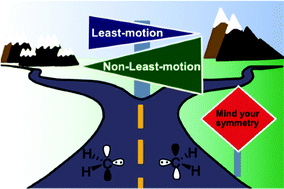Violations to the principle of least motion: the shortest path is not always the fastest
Abstract
The reaction between two molecules is usually envisioned as following a least-motion path with both molecules travelling minimum distances to meet each other. However, the reaction path of lowest activation energy is not only determined by practicality but mainly by the orbital symmetry of the involved reactants and the efficiency of their mutual interaction. The term non-least-motion was born to design those reactions in which reactants follow, in their route to products, pathways longer than those intuitively expected. In this review we summarize the theoretical and experimental studies that describe and rationalize reactions following non-least-motion paths, starting with the dimerizations of carbenes and followed by additional processes of these and other reactive species (silylenes, carbynes) such as insertions into single bonds and additions to π-bonds. Other examples involving less reactive partners are also included.

- This article is part of the themed collections: 2022 PCCP HOT Articles and PCCP Reviews


 Please wait while we load your content...
Please wait while we load your content...